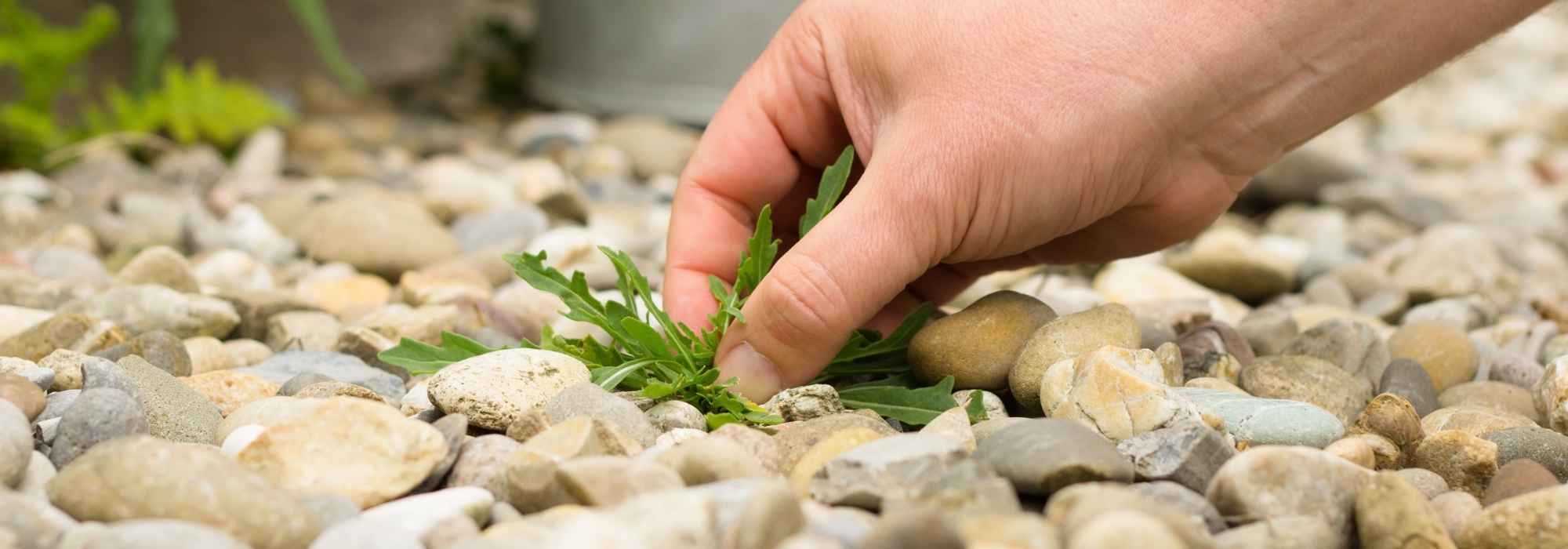
Weeding a patio, courtyard or pathway: our tips
Natural or mechanical solutions to (almost) bid farewell to weeds
Contents
With rising temperatures and spring rains, adventive plants are making their presence known once again… On paved pathways and terraces, in gravelled courtyards, weeds are reappearing, more resilient than ever. And since 2022, the Labbé law has banned the sale of synthetic plant protection products in France.
So, how can we get rid of them? How can we effectively weed these areas we want to keep visually perfect? Between manual solutions, innovative machines, organic weedkillers and old-fashioned remedies, let’s review the best ways to efficiently eliminate these unwanted guests.

The chore of weeding hard surfaces resumes as soon as the fine weather returns…
Traditional hand weeding tools: effective and eco-friendly
Nothing beats manual weeding for precise and long-lasting results. It’s a method that’s both ecological and economical. Admittedly, it requires patience and often needs repeating several times for a clean outcome. The elbow grease and crouching position may put some people off… But several essential tools make the task easier, each suited to either hard paved surfaces or softer gravel areas.
For patios and pathways:
- The weeding knife is the essential tool for removing herbs growing in narrow spaces between paving stones, bricks or slabs. This knife allows you to scrape weeds at ground level. Its thin, sharp blade makes working in crevices easier.
- The joint scraper is designed to remove moss and embedded herbs from the gaps in paved terraces. These two tools are best for occasional weeding work on small areas.
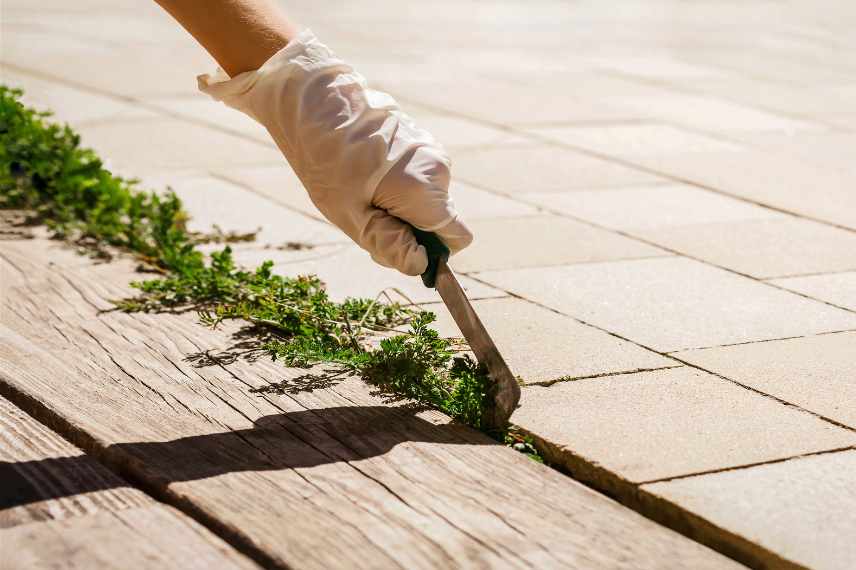
For gravelled courtyards:
- The hoe is an effective tool for weeding gravelled surfaces where adventives can take deeper root. It allows you to cut herbs at ground level without excessive effort. Its long handle prevents bending, making it practical for large areas.
- The dandelion weeder used in short grass meadows or flower beds is also very effective in gravelled courtyards for removing the most stubborn tap-rooted weeds.
- The stainless steel brush: this handy metal brush helps dislodge weeds from gaps and grooves, and completes the cleaning after pulling.
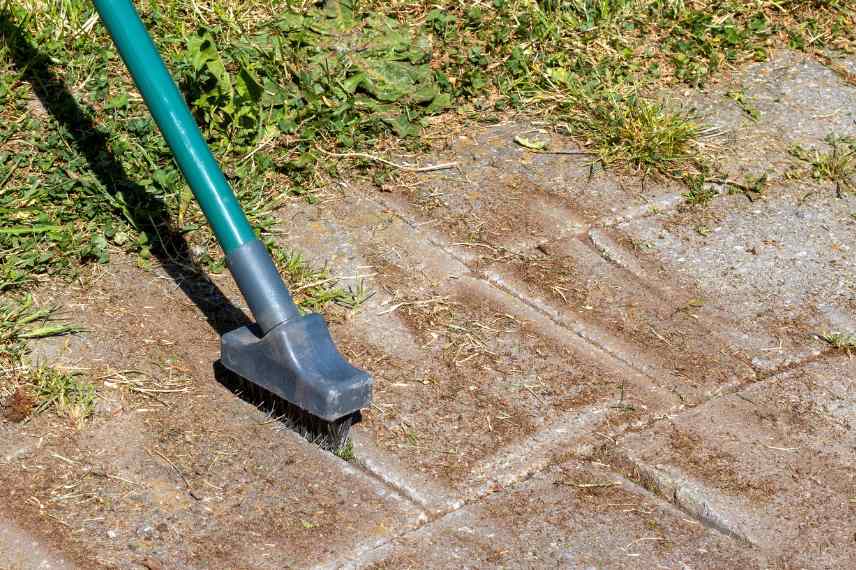
These tools offer a practical and durable solution, suitable for small areas or regular maintenance.
My tip: on gravel, work on a completely dry day – adventives will be easier to remove.
→ Also read our articles on the subject: Weeding: 7 tools that make the job easier; what is a weeding hoe for?, and what is a weeding knife for?
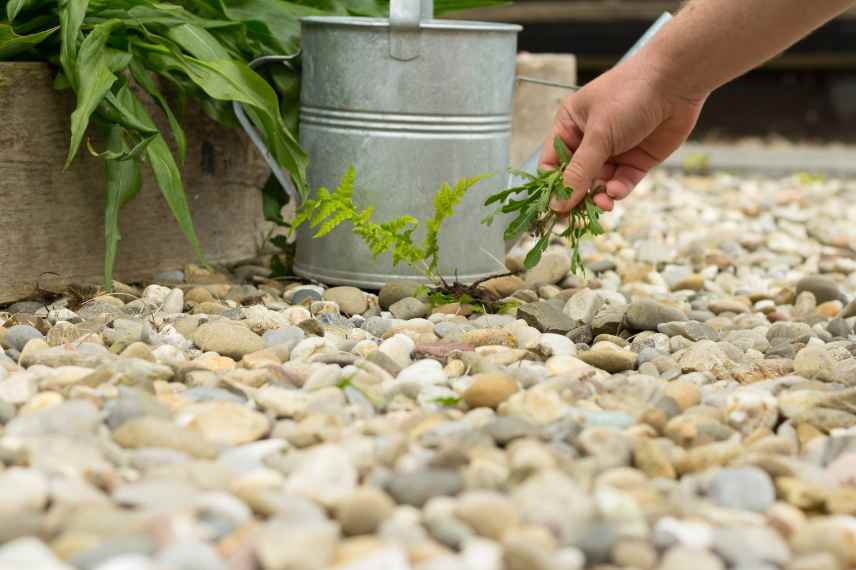
Some adventives even come away easily by themselves in dry weather
Machines: mechanical solutions for effortless weeding
For those who dread tedious manual weeding and wish to weed without physical effort, machines offer an alternative worth considering. They are particularly useful for treating large areas, making weeding quicker, though they do have some drawbacks.
- The thermal weeder: it burns unwanted plants in seconds by causing thermal shock. This is the ideal machine for paved pathways and patios. Using heat to eliminate weeds, this device is both ecological and effective. The heat destroys plant cells, causing them to die within a few days. It’s perfect for large surfaces like driveways and courtyards.
- The electric weeder: practical for small areas, this weeder operates using a heating element (direct flame or infrared). Its heating temperature typically reaches around 600°C, which is enough to eliminate weeds without damaging surrounding surfaces. It’s lightweight and easy to handle, making it ideal for patios and small gardens.
- The gas-powered weeder: effective for large zones, this weeder uses a flame to burn weeds. Different models reach temperatures between 600 and 1000°C. They allow for treating wide areas in a short time. However, they are slightly bulkier and heavier to handle.
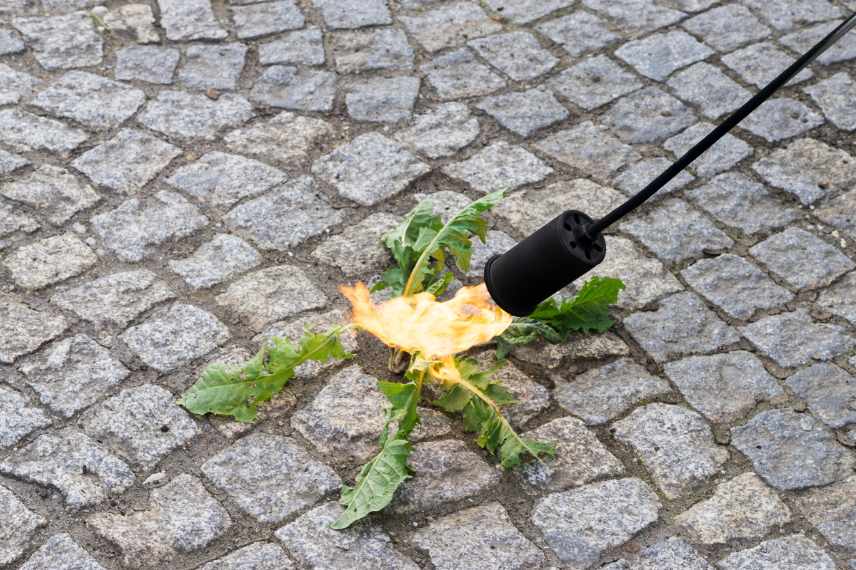
- The rotary brush weeder (mechanical sweeper) is suitable for stone or concrete surfaces and all hard, impermeable surfaces. Like all brushing tools, it cannot be used on stabilised or gravel surfaces. It removes weeds superficially, along with moss, by uprooting them.
- The pressure washer proves effective against moss and shallow-rooted weeds on hard surfaces. It’s more of a cleaning tool for mineral surfaces than a true weeding device. A pressure of around 150 to 200 bars is usually enough to dislodge weeds without damaging paving. Use a flat jet nozzle for precise and efficient cleaning.
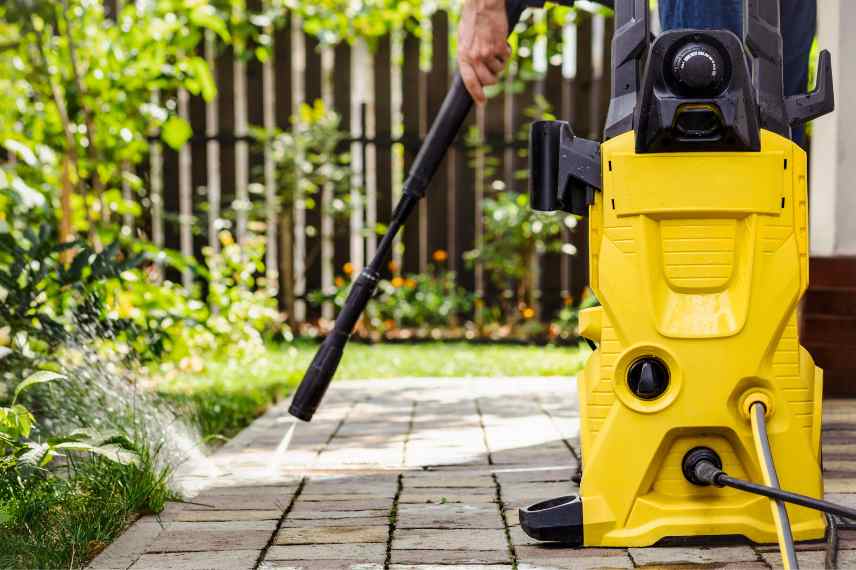
⊗ The pros and cons
These machines have several drawbacks, aside from being noisy and, in some cases, potentially dangerous to handle. Gas-powered models emit CO₂ and consume fossil fuels, while pressure washers use large amounts of water and electricity… Not as environmentally friendly as one might think…
Even more problematic, since the goal is to eliminate adventive plants, these devices destroy the above-ground parts of plants through thermal shock but do not significantly affect the roots. Perennial weeds, especially those with deep root systems, grow back even stronger.
These methods can make certain plants more resistant in the long term. The result? They come back even more vigorously!
→ Also read Our maintenance tips for beautiful, clean paving all year round and How to clean the joints in patio or pathway paving?
The new "weed killers": an interesting alternative
Since the ban on synthetic phytosanitary products (chemical weedkillers like glyphosate), what “weedkiller” options remain available on the market? Several organic solutions have emerged, including a wide range of natural weedkillers based on pelargonium, which have become essential.
- Weedkillers based on pelargonic acid (or nonanoic acid), a substance naturally present in certain plants (pelargoniums, the famous scented geraniums). They are most effective against young adventives. Extracted from geranium oil and fatty acids found in geranium leaves, they work by destroying plant cell membranes, causing them to dry out and die within hours. On the plus side, they are biodegradable and considered biocontrol products. They are available commercially as concentrates to dilute or ready-to-use solutions. They should be used when temperatures are mild (minimum 10-15°C), in spring or autumn, in windless conditions, and when no rain is forecast in the following hours. A second application is recommended 10 to 15 days after the first.
- Weedkillers based on acetic acid: highly concentrated in white vinegar, they quickly destroy plant cells by burning their leaves, particularly on mineral surfaces. They lower soil pH…
- Weedkillers based on caprylic and capric acid: composed of fatty acids found in certain vegetable oils, they work similarly to pelargonic acid by destroying plant cells. They are reputed to be more effective over time.
These solutions are both effective and environmentally friendly but generally require multiple applications for optimal results.
⊗ The pros and cons
Acids such as pelargonic acid have no residual effect in the soil, meaning weeds quickly regrow after application. The weed-free effect is therefore temporary, even if it offers a stunning visual impact a few hours after application.
More problematic, weedkillers based on pelargonic acid or acetic acid do not penetrate the roots; they only act on contact with the aerial parts. They are therefore ineffective against perennial adventives like bindweed or couch grass, which will regrow a few weeks after treatment.
Finally, scientific data on their toxicity with repeated applications remains limited.
Folk remedies: for natural and handy weed Control
If you’re looking for 100% natural and homemade solutions, several traditional tips can help limit the proliferation of unwanted herbs. These methods are easy to apply and require no special investment, as these products are usually already in your cupboard or kitchen. They can be used for mineral spaces but should not be adopted in the garden! However, these solutions require regular applications to be fully effective.
- White vinegar: an effective natural acid
Yes, it’s the same as in acetic acid-based weedkillers! Natural and eco-friendly, white vinegar is a good weedkiller. It’s very inexpensive, biodegradable, and volatile. Its acidity burns the leaves of weeds. Diluted or neat, spray it directly onto the leaves in dry weather. For optimal effectiveness, apply on sunny days. It is less effective on deep-rooted plants. - Boiling water (water from cooking rice, pasta, or potatoes): a quick method
Rich in starch, it works by burning herbs on the spot. Pour a dilution of water—preferably unsalted—directly onto cracks for immediate action. This method is most effective on young shoots. Its herbicidal effect works when the cooking water is boiling! Collect it right after cooking your potatoes and head to the terrace to water the joints between paving stones or, more conveniently, the gravelled courtyard. - Pure urine: a lesser-known weedkiller
Known for its fertilising action when diluted, it becomes a contact herbicide when used neat and in quantity! - Orange and lemon essential oils and, to a lesser extent, basil oil have a contact herbicidal effect when diluted with white vinegar and black soap. Limonene, found in citrus trees, works by drying out plants. But they do not destroy the roots and require several applications…
- Wood ash: a moderate preventive effect
Rich in mineral salts, it can slow the germination of adventives by slightly altering the soil’s pH. Its effect is mainly preventive and temporary, limited to slowing regrowth. Sprinkle it on areas to be weeded, in lines 1 cm thick. - Salt, to be used sparingly to avoid harming soil life and groundwater! Salt can indeed sterilise the soil if used in large quantities. Sprinkle a small amount of coarse salt, ideally, directly onto weeds in paving cracks to dehydrate them.
- Bicarbonate of soda: suitable for weeding paved areas, bicarbonate of soda raises the soil’s pH, making life difficult for adventives. Be careful with dosage, as like salt, it has a negative effect on soils. Sprinkle it directly onto weeds or dilute it in water before spraying. It works well on paved surfaces to limit the regrowth of adventives.
Read also: So-called “natural” weedkillers: what do they really contain?
The golden rules for maintaining hard surfaces in the garden
As you’ll have gathered from reading this article in full… there is still no miracle solution for eliminating 100% of weeds from paving, stonework or gravel. As Virginie D. rightly points out in Weeding… the natural way, “there is no natural or organic weedkiller that is selective, total and permanent”, as these products leave no residual effect in the soil. They only act as a contact weedkiller.
Some plants, like red clover, may be more resistant than others to the effects of pelargonic acid due to their physiological characteristics.
However, it’s worth bearing a few key points in mind:
- Focus on regular maintenance: regular manual weeding helps control weeds before they become too established and invasive. Regular sweeping and cleaning of hard surfaces helps remove weed seeds before they germinate. On gravel, take care not to let leaves accumulate – they’ll become the perfect breeding ground (quite literally) for future weeds…
- Combine different approaches: while manual weeding remains preferable, you can alternate it with the less labour-intensive methods mentioned above.
- Proper implementation on paving, stonework and gravel: systematic installation of geotextiles is essential (though not miraculous). Jointing between slabs and paving stones must be impeccably done and maintained over time.
- Repeat applications: applying weedkiller several times to gradually weaken plants is a tried-and-tested technique.
- Always ensure you remove the entire root when weeding manually.
- Always wear protective gloves and prevent access to treated areas by pets and children for at least an hour afterwards, even with biocontrol products.
- Treat during dry, sunny weather to maximise effectiveness.
- Finally, rural areas and gardens with rich biodiversity will always be more prone to weeds due to birds and animals transporting seeds…
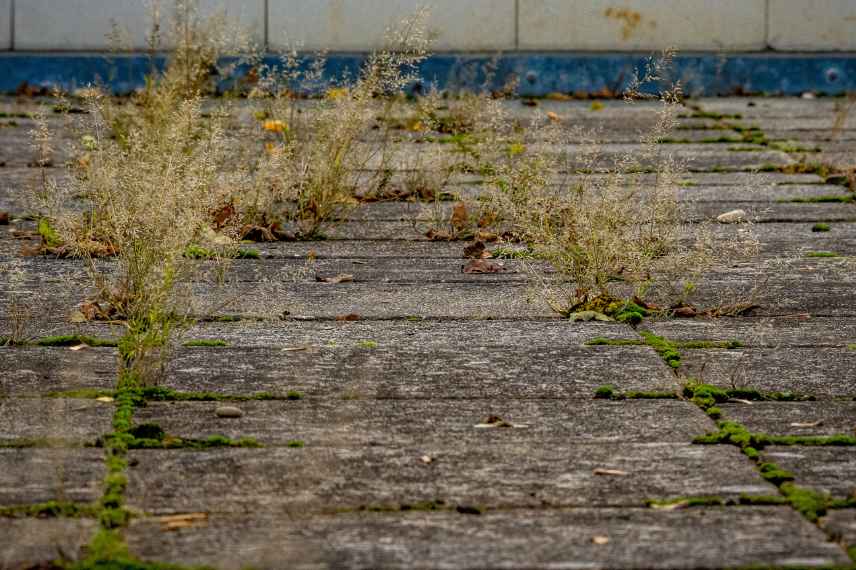
Don’t neglect maintenance of paved areas
Which treatment to choose for which adventive?
To complete this information, here are the most effective methods for dealing with different types of adventive herbs:
| Type of adventive herb | Effective method | Precautions |
| Moss and lichens (on patios and paving) |
Pressure washer, wire brush, white vinegar | Avoid excessive pressure on joints |
| Annual herbs (Poa annua, chickweed) |
Thermal weeding, pelargonic acid | Apply during dry periods for better effectiveness |
| Perennial adventives (dandelion, couch grass, bindweed) |
Manual removal with weeding knife or hoe, repeated pelargonic acid application | Remove the entire root to prevent regrowth |
| Rhizomatous herbs (couch grass, horsetail) |
Deep manual weeding, preventive geotextile | Avoid thermal weeding which encourages regrowth |
- Subscribe!
- Contents
































Comments